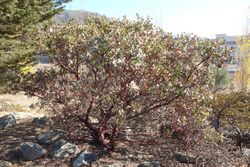Biology:Arctostaphylos obispoensis
| Arctostaphylos obispoensis | |
|---|---|

| |
| Scientific classification | |
| Kingdom: | Plantae |
| Clade: | Tracheophytes |
| Clade: | Angiosperms |
| Clade: | Eudicots |
| Clade: | Asterids |
| Order: | Ericales |
| Family: | Ericaceae |
| Genus: | Arctostaphylos |
| Species: | A. obispoensis
|
| Binomial name | |
| Arctostaphylos obispoensis Eastw.
| |
Arctostaphylos obispoensis is a species of manzanita, known by the common names bishop manzanita and serpentine manzanita, endemic to California .[2]
Distribution
The plant is endemic to the southern Santa Lucia Mountains, in the Central Coast region of California.[2] It is found primarily in San Luis Obispo County, and extends into southern Monterey County.[2][3]
It grows in chaparral and closed-cone pine forest habitats, usually on serpentine soil. It is found at elevations of 60–950 metres (200–3,120 ft).[4]
- Conservation
It is protected within the Cuesta Ridge Botanical Special Interest Area of the Los Padres National Forest, growing in the endemic Sargent cypress (Cupressus sargentii) forest.[5] The species is listed on the California Native Plant Society Inventory of Rare and Endangered Plants as a rare but not currently endangered species.[6]
Description
Arctostaphylos obispoensis is an upright shrub or multi-trunked tree growing to 1–4 metres (3.3–13.1 ft) in height.[2][4]
The small branches and newer leaves are woolly. The mature leaves are glaucous-gray, hairless, and oblong (northern range) to widely lance-shaped (southern range), and up to 4.5 centimeters long.[4]
The inflorescence is a dense cluster of white urn-shaped and downward facing "manzanita" flowers.
The red fruit is a round waxy drupe, 9–14 millimetres (0.35–0.55 in) in diameter.[4]
See also
- Arctostaphylos luciana — range adjacent on west side of Cuesta Ridge
- Arctostaphylos pilosula — range adjacent on east side of Cuesta Ridge
- Natural history of the California chaparral and woodlands
References
- ↑ "NatureServe Explorer - Arctostaphylos obispoensis". NatureServe. 2022-05-30. https://explorer.natureserve.org/Taxon/ELEMENT_GLOBAL.2.133930.
- ↑ 2.0 2.1 2.2 2.3 "Field Guide to Manzanitas," Michael Kauffmann, Tom Parker, & Michael Vasey, Backcountry Press, 2015, ISBN:978-1-941624-02-9, page 98.
- ↑ Calflora: Distribution map
- ↑ 4.0 4.1 4.2 4.3 Jepson[yes|permanent dead link|dead link}}]
- ↑ Los Padres National Forest: Cuesta Ridge Botanical Special Interest Area
- ↑ CNPS, Rare Plant Program. 2016. Inventory of Rare and Endangered Plants (online edition, v8-02). California Native Plant Society, Sacramento, CA. — Arctostaphylos obispoensis . accessed 1.16.2016.
External links
- Calflora Database: Arctostaphylos obispoensis (Bishop manzanita, Serpentine manzanita)
- Jepson Manual eFlora (TJM2) treatment of Arctostaphylos obispoensis[yes|permanent dead link|dead link}}]
- USDA Plants Profile for Arctostaphylos obispoensis (serpentine manzanita)
- UC Photos gallery — Arctostaphylos obispoensis
Wikidata ☰ Q4787685 entry
 |







